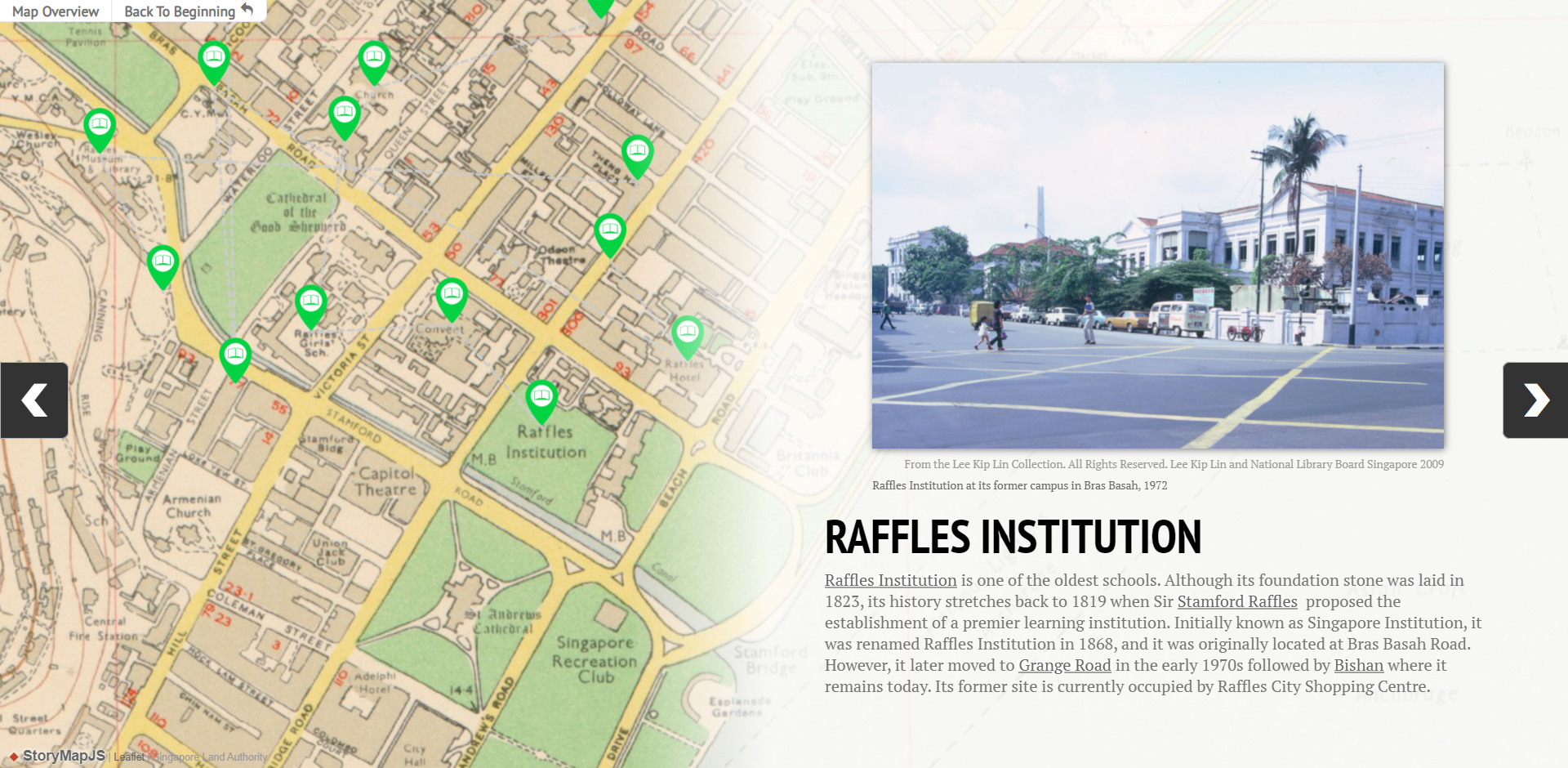Bras Basah: A Place Of Learning
Schools of Bras Basah
The close proximity of Bras Basah to the town centre and various ethnic enclaves of Singapore made it an ideal location for schools during the colonial period. Started by town planners, missionaries and philanthropists, these early schools provided local children an invaluable opportunity for education regardless of gender, race and religion. Here is a selection of those schools.
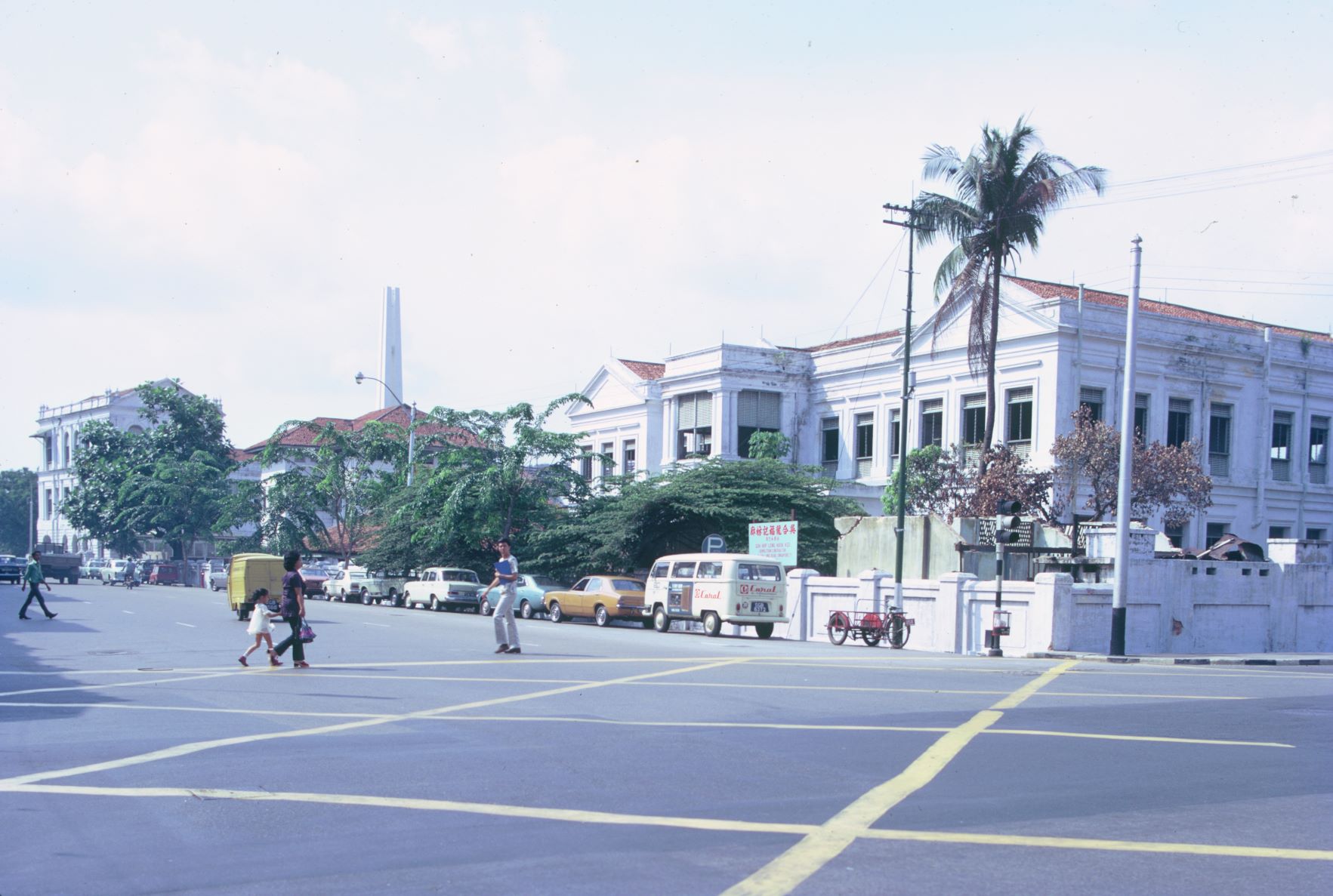 |
| Raffles Institution is one of the oldest schools in Singapore. Although its foundation stone was laid in 1823, its history goes back to 1819 when Sir Stamford Raffles proposed the establishment of a premier learning institution. Initially known as Singapore Institution, it was renamed Raffles Institution in 1868, and was originally located at Bras Basah Road. It moved to Grange Road in the early 1970s and then to Bishan where it remains today. Its former site is currently occupied by Raffles City Shopping Centre. (Image Credit: All Rights Reserved. Lee Kip Lin and National Library Board Singapore 2009){:target=”_blank”}) |
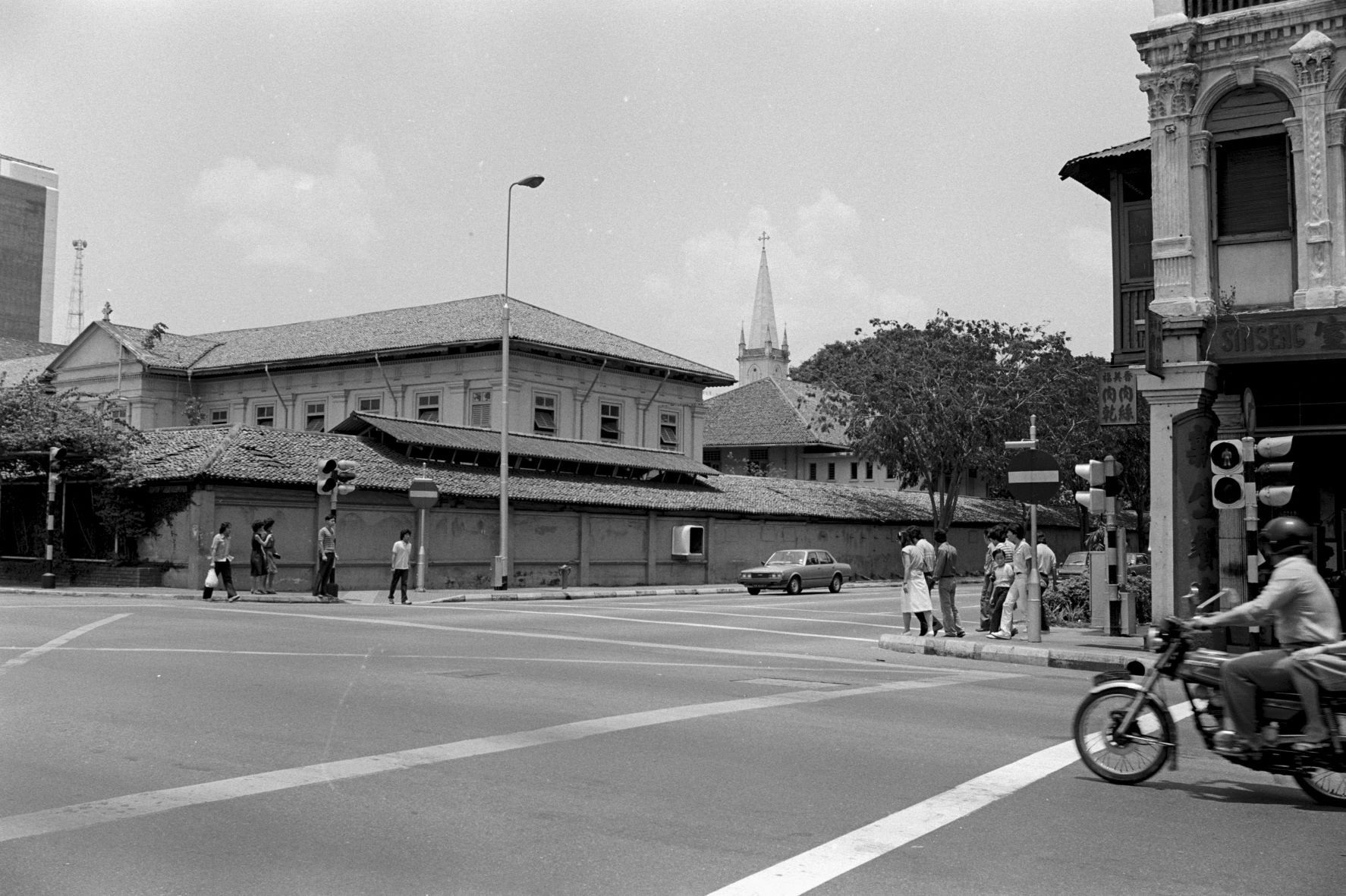 |
| Convent of the Holy Infant Jesus (CHIJ) is the oldest Catholic girls’ school in Singapore. Founded in 1854 by the French sisters of the Congregation of the Holy Infant Jesus, the school was located at the corner of Bras Basah Road and Victoria Street (presently CHIJMES). In December 1983, the school moved to a new site in Toa Payoh to make way for the Mass Rapid Transit (MRT) headquarters. Following the move, its primary and secondary schools were renamed CHIJ Primary (Toa Payoh) and CHIJ Secondary (Toa Payoh). (Image Credit: All rights reserved. Lee Kip Lin and National Library Board, Singapore 2009) |
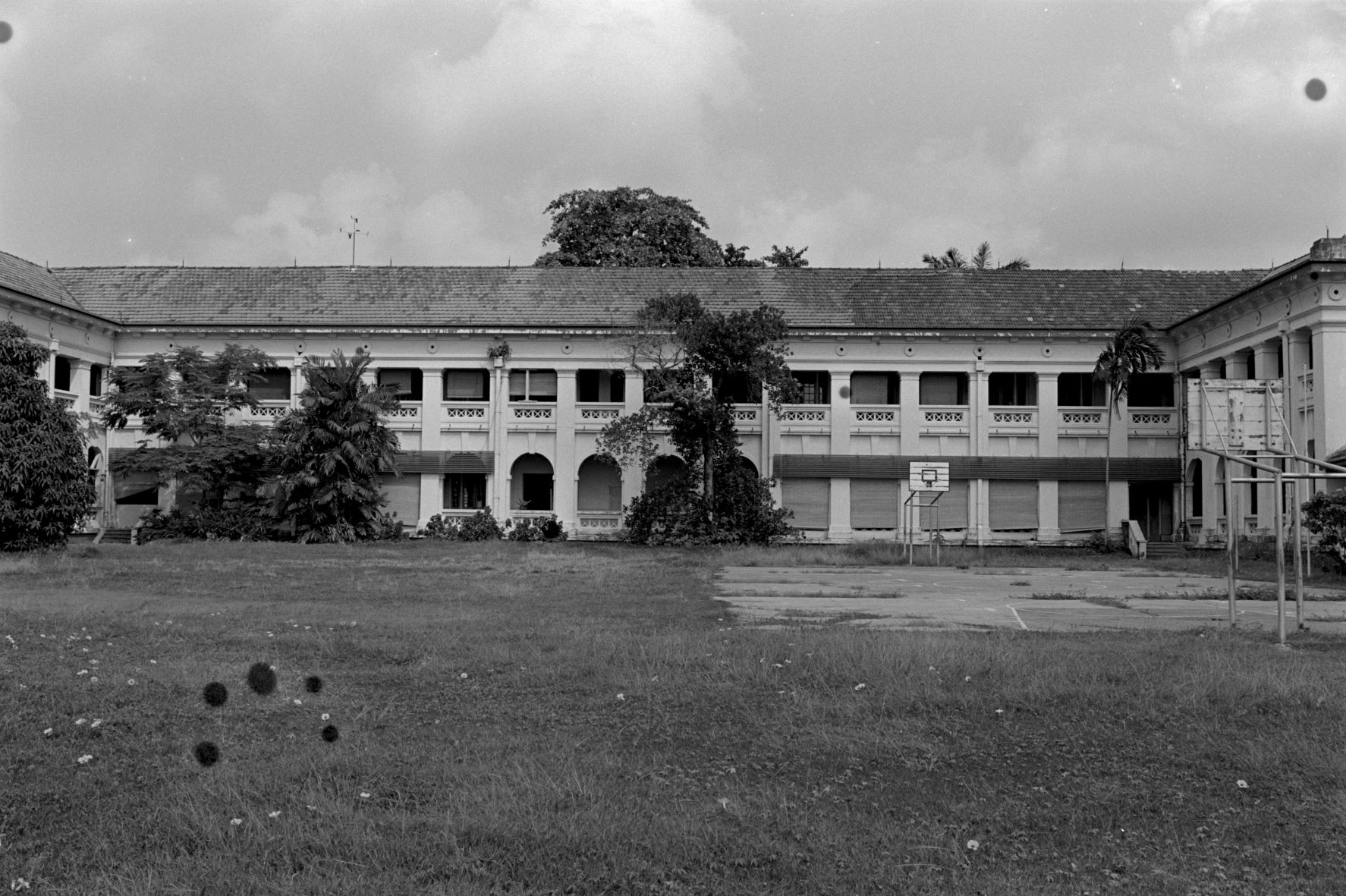 |
| Raffles Girls’ School (RGS) started as a one-room department within Raffles Institution in 1844 before it was officially established in 1879 with 77 students. As the school expanded, it moved to new premises on Queen Street in 1928 and became a full-fledged girls’ school. In 1959, the school moved to Anderson Road before settling on its present Braddell Rise campus in 2019. Today, the school’s former Bras Basah site is occupied by the Singapore Management University’s School of Business.(Image Credit: All rights reserved. Lee Kip Lin and National Library Board, Singapore 2009) |
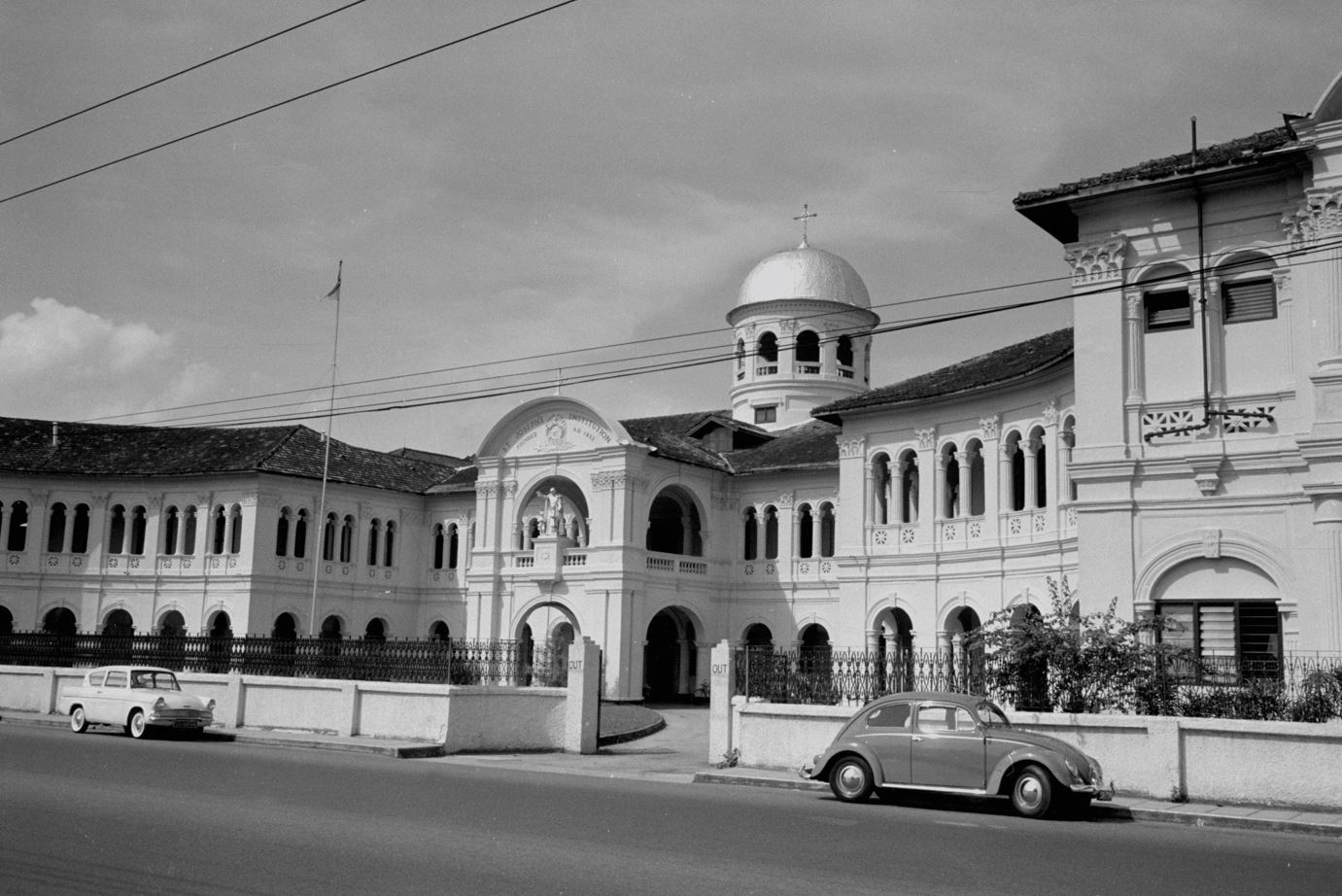 |
| St Joseph’s Institution (SJI) was founded in 1852 by Father Jean-Marie Beurel of the Missions Étrangères de Paris (The Society of Foreign Missions of Paris). Before moving to its current location on Malcolm Road in 1988, it occupied the present site of the Singapore Art Museum along Bras Basah Road. The original SJI building was completed in 1867 and comprised a cluster of blocks featuring a classical style reminiscent of the European Renaissance. It was gazetted on 14 February 1992. (Image Credit: Courtesy of National Archives of Singapore) |
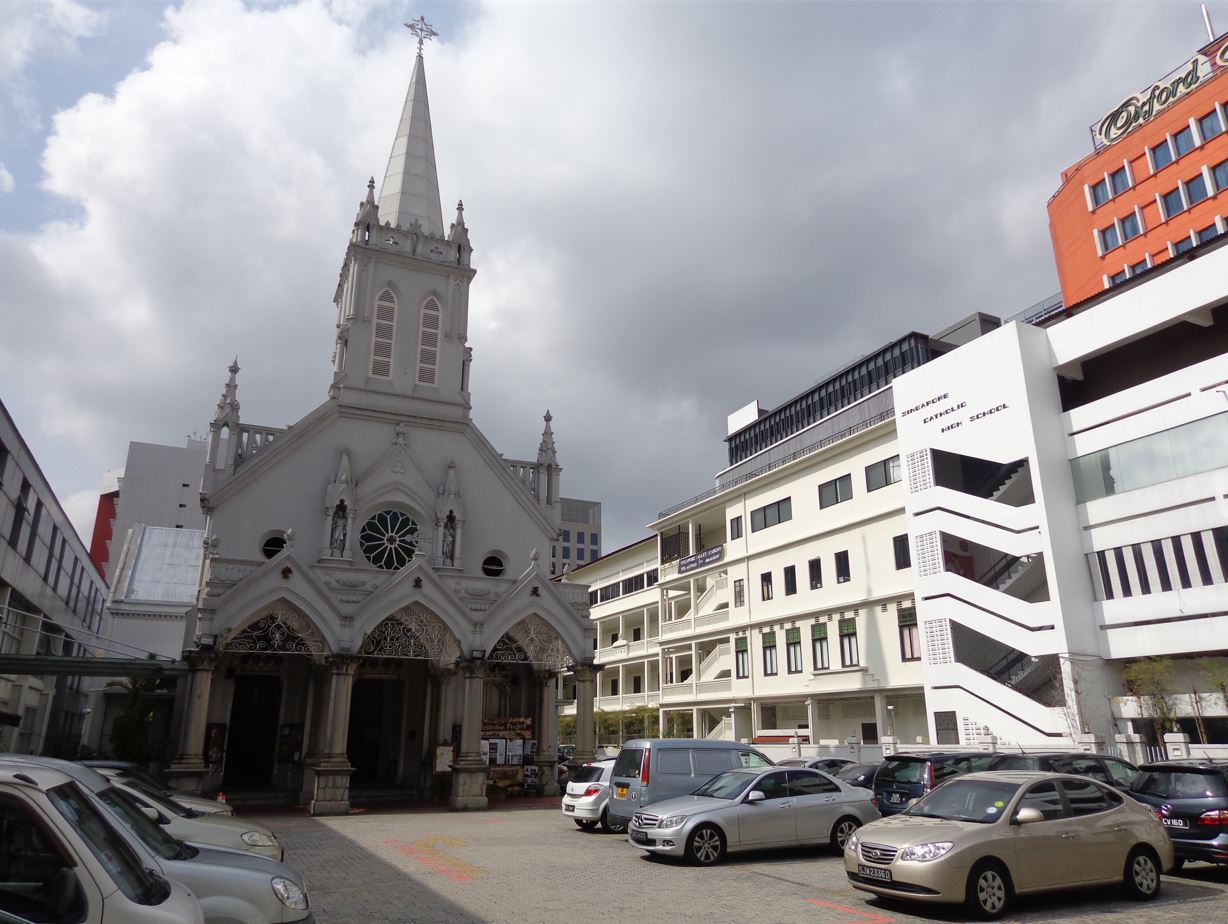 |
| Catholic High School (CHS) is one of Singapore’s highly regarded institutions. Although it was established as a Catholic institution, it enrolled both Catholic and non-Catholic students. The school was founded in 1935 by French missionary Rev. Fr. Edward Becheras in the premises of the Church of St Peter and Paul (pictured) on Queen Street. CHS relocated to Bishan in 1992. (Image Credit: Photo by Iloilo Wanderer via Wikicommons) |
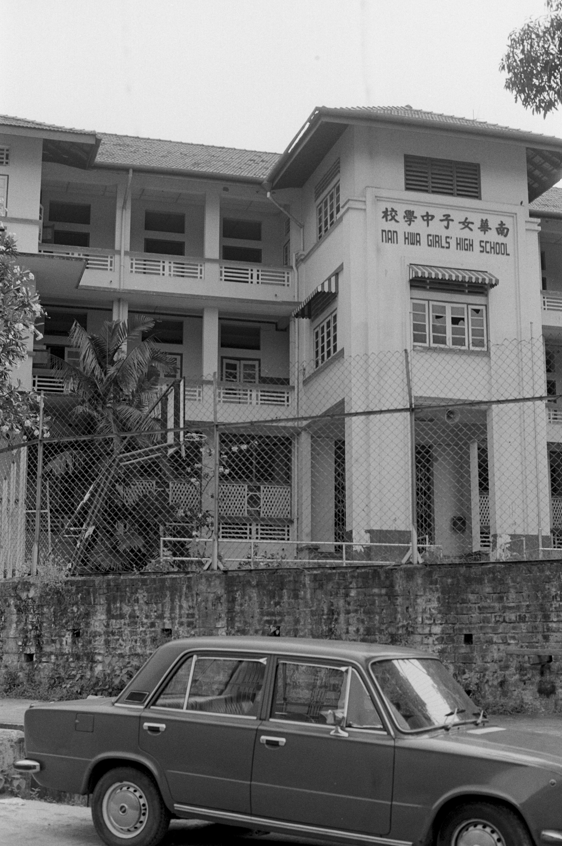 |
| Nan Hwa Girl’s Chinese School started as a makeshift school in Coleman Street with fewer than 100 Chinese girls before moving to a proper building along Bencoolen Street in 1921. Throughout the 1920s and 1930s, the school population grew as the school not only provided education for students, but also basic training for teachers. To cope with the rise in enrolment, a second move was initiated and the school ended up at Adis Road in 1941. In 1982, the school was relocated again but this time to Clementi Avenue 1. There, it became a co-ed school and is known today as Nan Hua Secondary School. (Image Credit: From the Lee Kip Lin Collection. All rights reserved. Lee Kip Lin and National Library Board, Singapore 2009) |
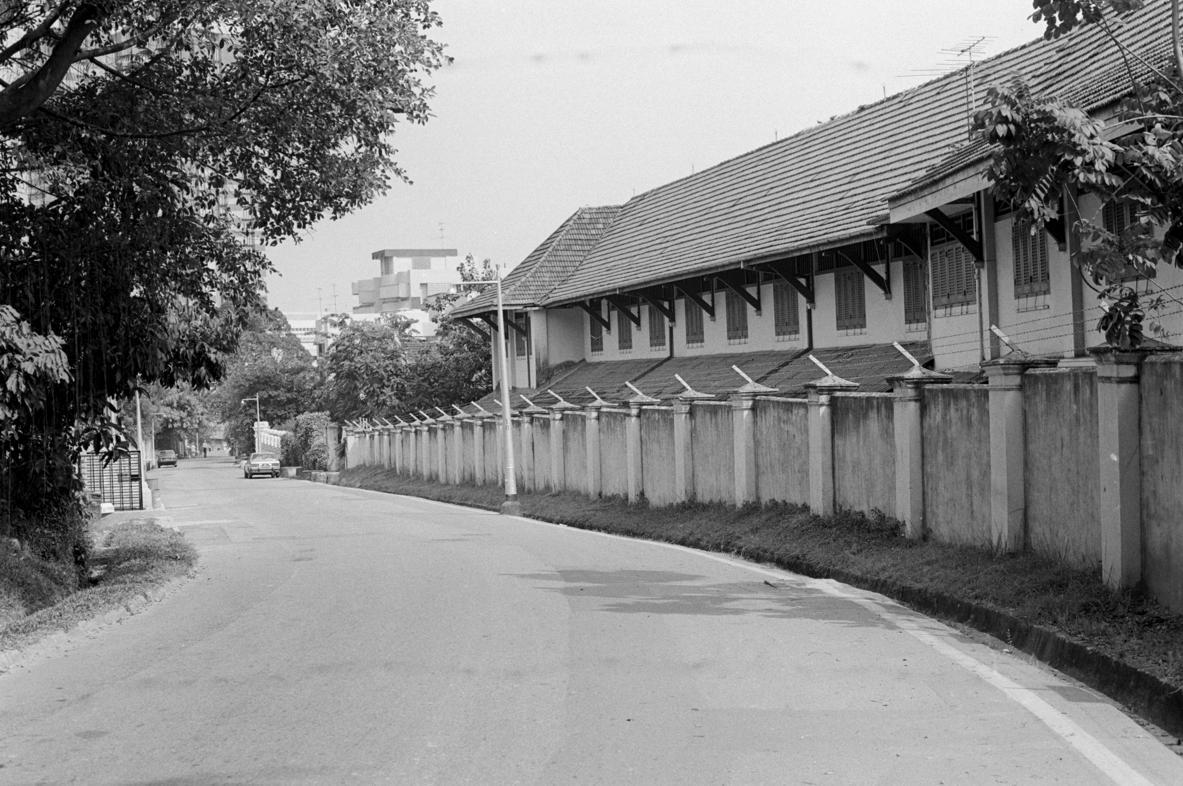 |
| St Margaret’s School, Singapore’s oldest school for girls, was established in 1842 by missionary Maria Dyer. St Margaret’s School began as a missionary effort to save mui tsai (“Little sister” in Cantonese), or bonded domestic servant. It was the first school for girls in Singapore established in a time when the education for women was considered unimportant. The school was initially located in a shophouse on North Bridge Road before moving to 134 Sophia Road in 1861. It would remain there until 1960 before the secondary-school section was separated from the primary-school section. The former would then move to 111 Farrer Road, while the latter remained at the Sophia premises for a period before relocating to 99 Wilkie Road (shown above). Today, the two schools are still located on the two roads. (Image Credit: From the Lee Kip Lin Collection. All rights reserved. Lee Kip Lin and National Library Board, Singapore 2009) |
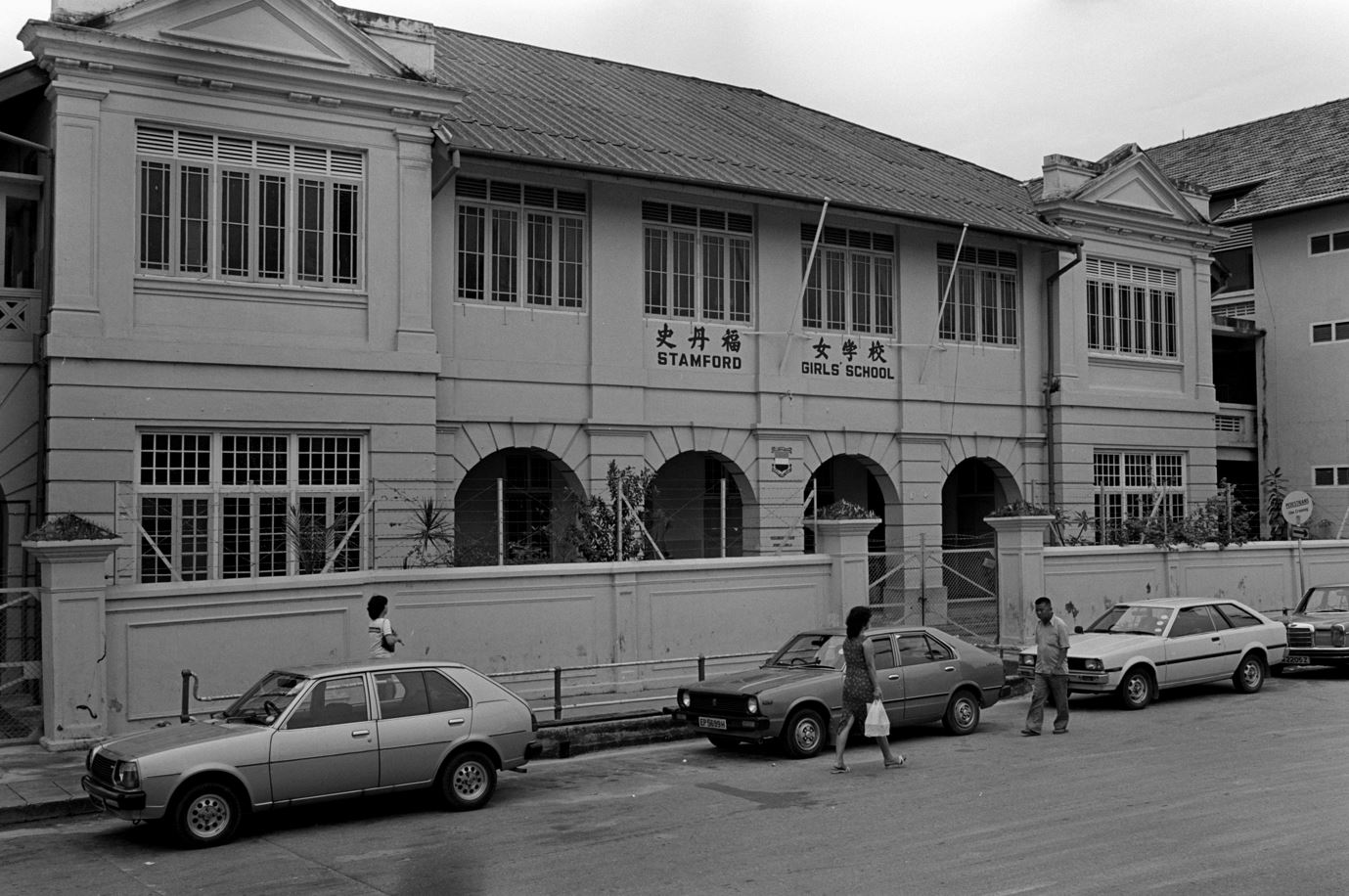 |
| Stamford Girls’ School was established in January 1951 to cater for children from the Middle Road, Waterloo Street, Queen Street and Selegie Road areas. Located at 1 Victoria Lane, its former premises was built in 1920. The name “Stamford Girls’” was chosen by the then principal of Raffles Girls’ School, Miss M. Hadley, as she wanted it to be a sister school to Raffles Girls’. However, the plan was later dropped. In 1984, Stamford Girls’ would combine with Waterloo Girls School to form Stamford Primary School before moving to Victoria Lane in 1986. The building was then conserved in 1994 and is now occupied by the Stamford Arts Centre. (Image Credit: From the Lee Kip Lin Collection. All rights reserved. Lee Kip Lin and National Library Board, Singapore 2009) |
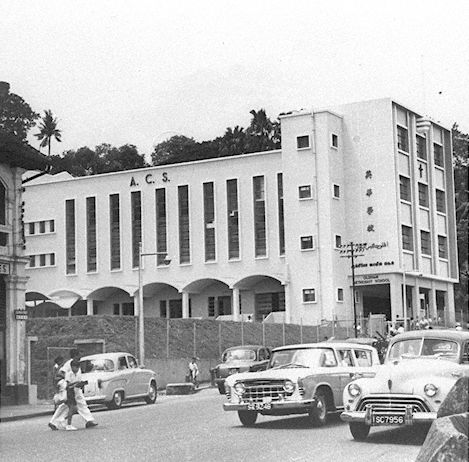 |
| The Anglo-Chinese School (ACS) in Singapore was founded on 1 March 1886 by Reverend William Fitzjames Oldham, the founder and bishop of the Methodist Church in Malaya. The school started with only 13 pupils in a shophouse at 70 Amoy Street. It relocated to bigger premises on Coleman Street the following year. In 1956, the old school building and chapel were demolished and replaced by a new 30-classroom block in 1959. It served as the home of Anglo-Chinese Primary School until it moved to Barker Road in 1994. ACS now has six related schools around Singapore serving primary, secondary and junior college students. It has an international school as well. Part of ACS’ former premises on Coleman Street is presently occupied by the National Archives of Singapore. The Singapore Philatelic Museum next door uses what was an old ACS old school building as well. Currently closed for upgrading, it will reopen as the Children’s Museum Singapore by the end of 2022. (Image Credit: Tan Kok Kheng Collection, courtesy of National Archives of Singapore) |
These early schools of Bras Basah are among Singapore’s oldest and most prestigious education institutions. However, most of them have out of the area by the early 1980s. Click or tap HERE to reveal below the former principal of Raffles Institution (1986-1994) Eugene Wijeysingha's explanation why these schools were relocated. (Source: National Archives of Singapore)
"From as early as the 1930s, the building in Bras Basah was already beginning to show signs of serious wear and tear. Leaking, threatening also [to collapse]. One block had to be pulled down because it posed a serious threat to the safety of people. It was then an issue of whether to re-build on the existing site or move elsewhere. I am quite sure that the decision to move was part and parcel of the whole process of urban renewal. There must have been talk even then of expanding the business district. And that was quite a valuable piece of land. Even then, the town planners must have seen a point in our development when all the schools located in the city centre would have to move out. That actually has happened. RGS [Raffles Girls’ School), Consent of The Holy Jesus, Catholic High School [and] St Joseph’s Institution [have all moved out]. This must have been part of the whole process."
Bookstores in Bras Basah
For any local who lived through Singapore’s nation-building years, “books, stationery and printing services” might be among the words that spring to mind when they think of Bras Basah Road. Back then, Bras Basah Road and the ones surrounding it, such as North Bridge Road, New Bridge Road and Cashin Street, used to house shophouses famous for these services.
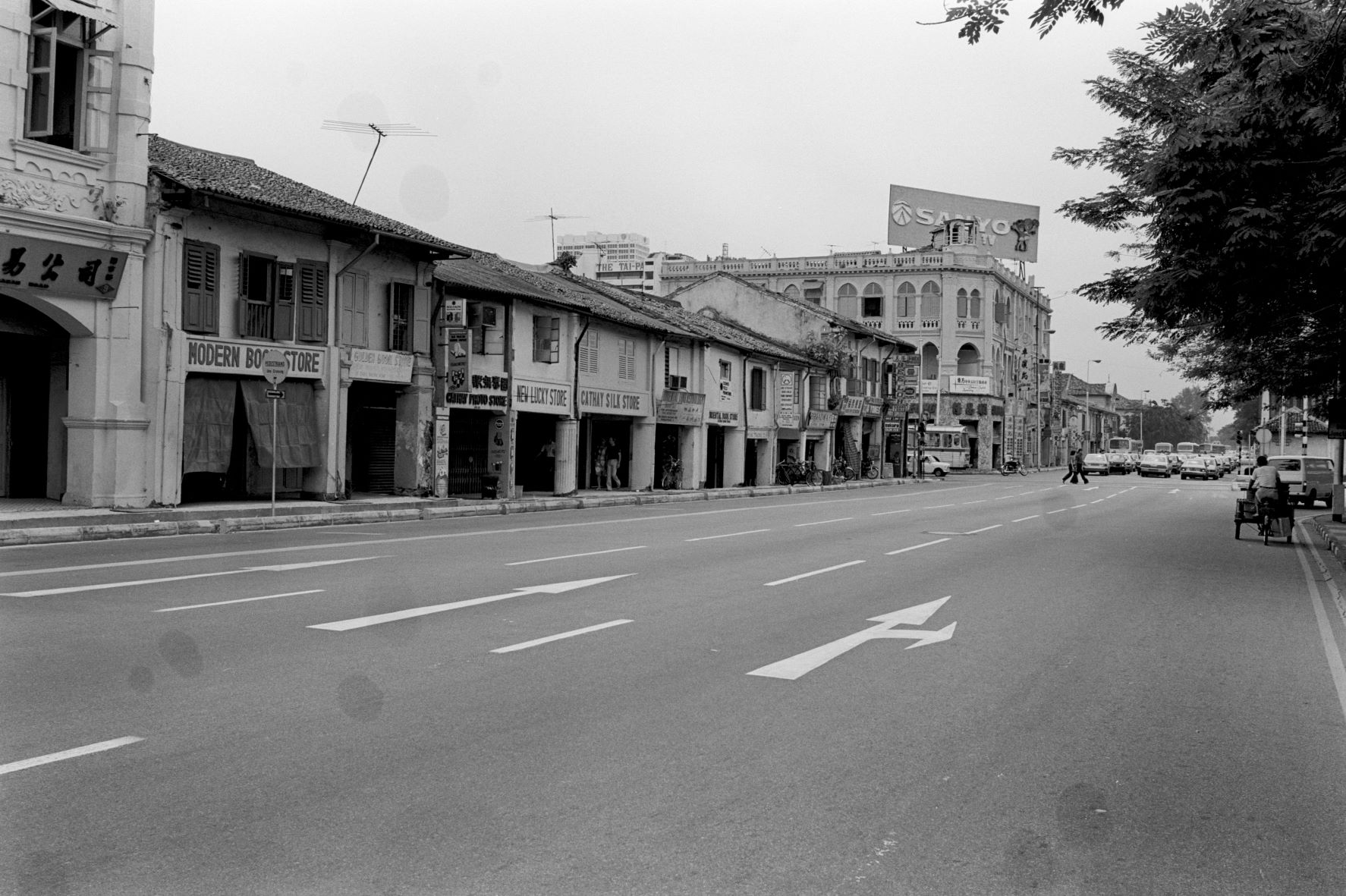 |
| As seen in the photograph above, there were many bookstores along Bras Basah Road during the nation-building years. The road thrived as a popular haunt for students searching for second-hand textbooks especially towards the end of the year-end school holidays. (Image Credit: All rights reserved. Lee Kip Lin and National Library Board, Singapore 2009) |
Click or tap HERE to reveal below Mr N I Narayanan's recollection of how he would look for textbooks in second-hand bookstores in the Bras Basah area when he was a student. (Source: National Archives of Singapore)
"As I said society itself was not really that affluent, it was common to go around to buy at the second-hand book shops. Once you have finished your schooling this year, you go to the second-hand book shop in Bras Basah Road…On the left-hand side opposite what used to be the YMCA Tennis Court and across Bencoolen Street there were also three or four, where books, second-hand books were sold…when it came to around December before schools reopen in January, everybody would rush to go and get the books…depending on the price and the condition, you could bargain over the price, of course the few cents, whereas the other costs three or four times as much. So those who could not afford better type one would take even tatted ones…basic thing was they all contained the same material in different conditions of wear and year. So, every year, you finished with your book for this year, unless you [had] children who [were] going to come in the next year or two, [then] you [would] keep [the textbooks] at home rather than go and sell and re-buy…I think they are all printed by the Malaya Publishing House or so, the premier publishing house in those days."
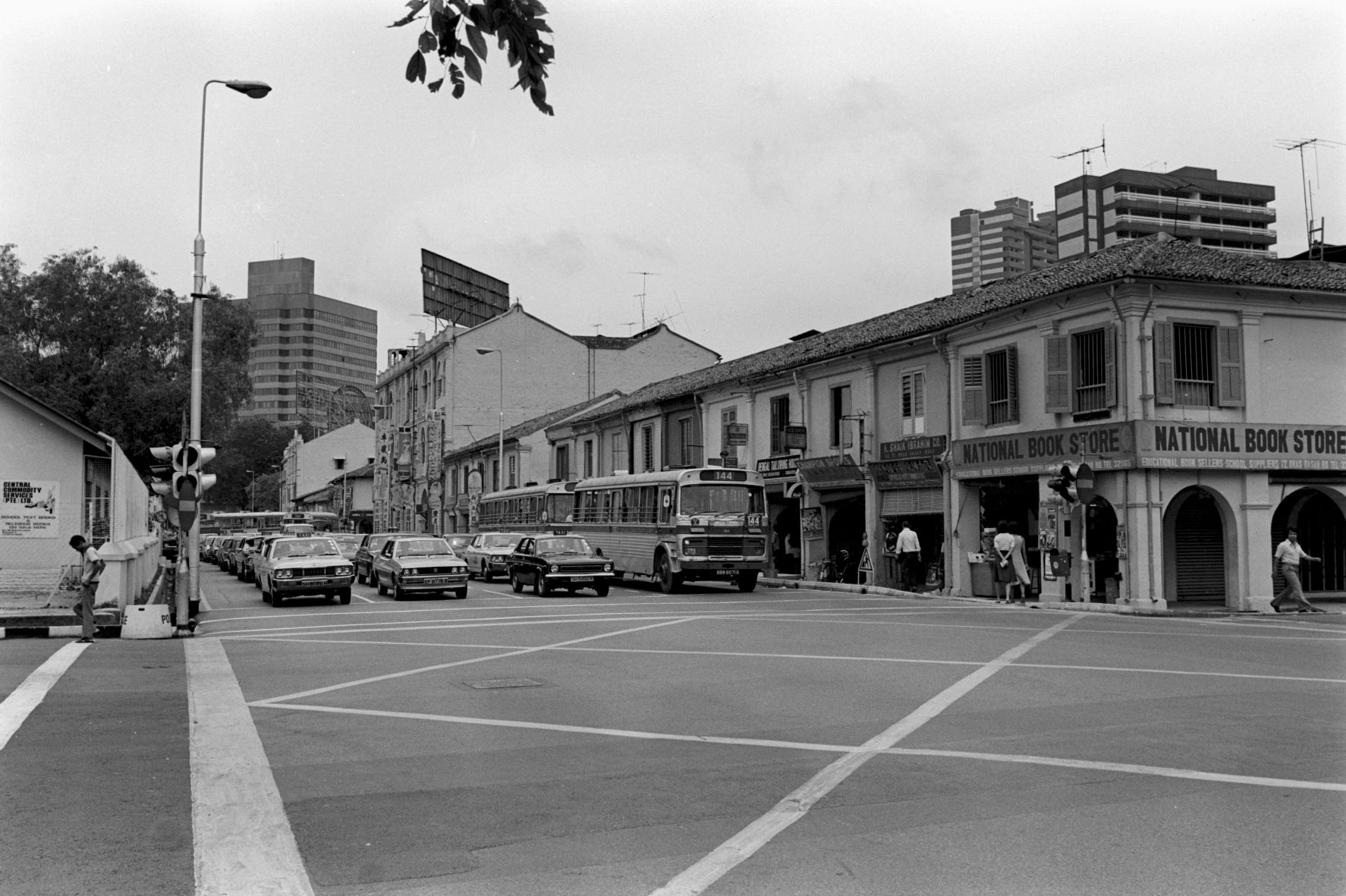 |
| The students who visited these bookstores such as Modern Book Store and National Book Store were not only from nearby schools such as Raffles Institution, Convent of the Holy Infant Jesus and St Joseph’s Institution, but also other parts of Singapore. (Image Credit: All rights reserved. Lee Kip Lin and National Library Board, Singapore 2009) |
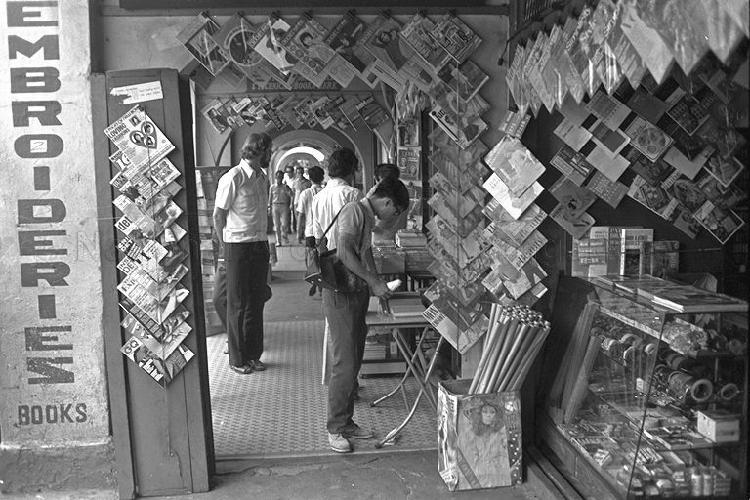 |
| Besides students, the general public was also drawn to the area for its affordable books and stationery, allowing Bras Basah to cement its reputation as the city of books. (Image Credit: National Archives of Singapore) |
When Mr Yeo Hong Eng was a student in the 1950s, he used to travel all the way from Changi to Bras Basah with his father for books. Click or tap HERE to reveal below how he remembers the trip there and the things he saw in the bookstores. (Source: Yeo Hong Eng)
"It was in one of the mornings of early January 1959, we went to Bras Basah Road via the No. 1 red and white Changi bus...I was lost for words when we walked along the corridors of the shops. Almost every shop was a bookshop – old and new. Periodicals, newspapers, weekenders, magazines..., school textbooks..., fictional books, non-fiction books of varied different genres, stationery, etc. I felt groggy. To try to save a few dollars, we tried to hunt from the second-hand book stores. I remembered that I was excited when I got one of the books. It was entitled “The World.” It was a Geography book. Then we proceeded to the book stores that sold new ones. We went in and out almost all the shops from the whole length of Bras Basah Road from Victoria Street to Prinsep Street...When I reached home I spent some time to wrap up those books I purchased with either brown Manila paper or expired monthly calendar with the unprinted back facing out. I found it too precious to dog-ear my books to indicate the pages that I stop referring to. I used chicken feathers as bookmarks. I was excited when I saw some fine feathers actually ‘growing’ from the main ones. I could not believe it. But when checked with some adult friends, they confirmed that feathers put in between books could grow. Surprise? Surprise? Surprise? That was my first experience of book purchasing."
Methodist Publishing House and Koh & Company
Two of the biggest English bookstores that used to be located in Bras Basah was Methodist Publishing House (MPH) and Koh & Company. Each of them offer a distinctive selection of books for their customers. Find out what they sell below.
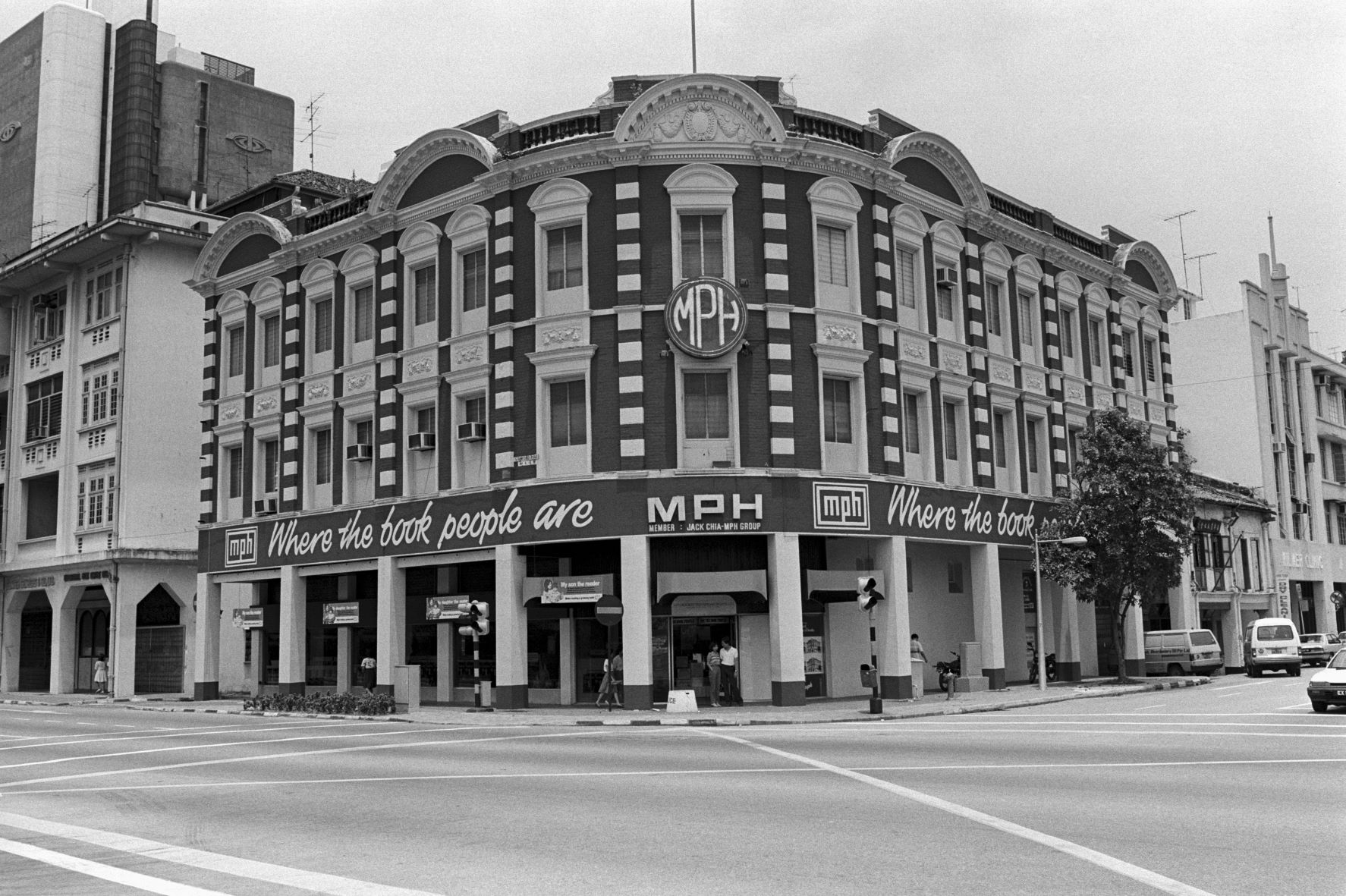 |
| Known as the “Grand Dame of Bookstores”, MPH began as Amelia Bishop Press in 1890. It was originally located in a shophouse at the junction of Selegie and Sophia roads. It then moved to Raffles Place in 1893 before ending up at the three-storey red-brick and plaster Vanguard building at the junction of Armenian Street and Stamford Road in 1908. (Image Credit: From the Lee Kip Lin Collection. All rights reserved. Lee Kip Lin and National Library Board, Singapore 2009) |
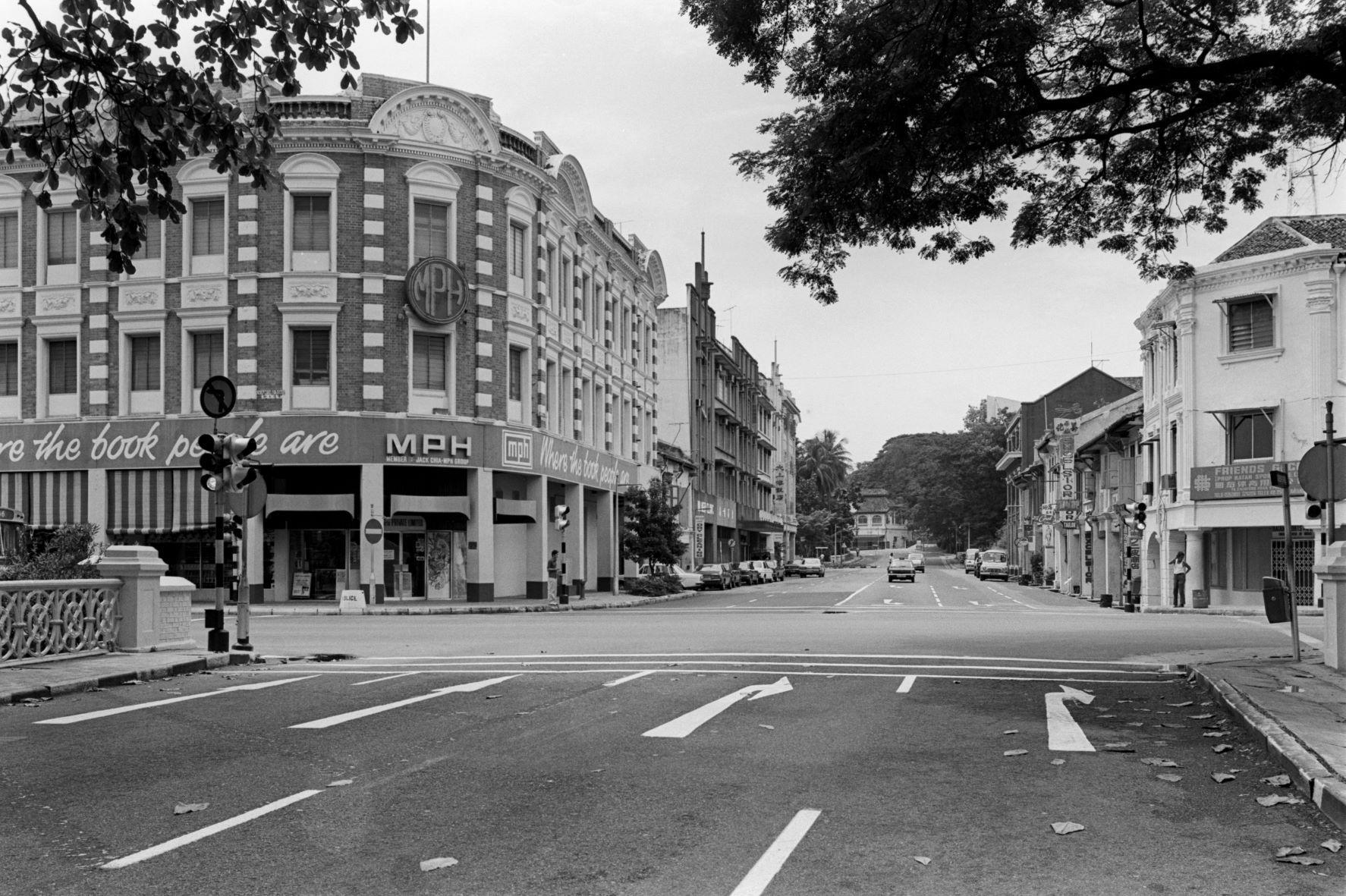 |
| This Edwardian-style building was built in 1908 by architectural firm Swan and Maclaren. MPH remained at the Armenian Street and Stamford Road site until 2002 when it sold the building. A year later, the building was gazetted for conservation. (Image Credit: From the Lee Kip Lin Collection. All rights reserved. Lee Kip Lin and National Library Board, Singapore 2009) |
Singaporean playwright Stella Kon used to visit MPH in Bras Basah when she was young. Click or tap HERE to reveal below what the bookstore sold from her oral history interview. (Source: National Archives of Singapore)
"There was the MPH at the Stamford Road side…they mostly sell I think textbooks and locally printed textbooks such as Mrs Handy Cookbook and their own range of workbook and stationery. For example, there was a workbook there for local schools showing a policeman with wings…[these] are [actually] boards sticking out from their backs so that they are more visible when they direct traffic. I think that was the intention. Obviously it was real wings so that he could fly after crooks to catch them."
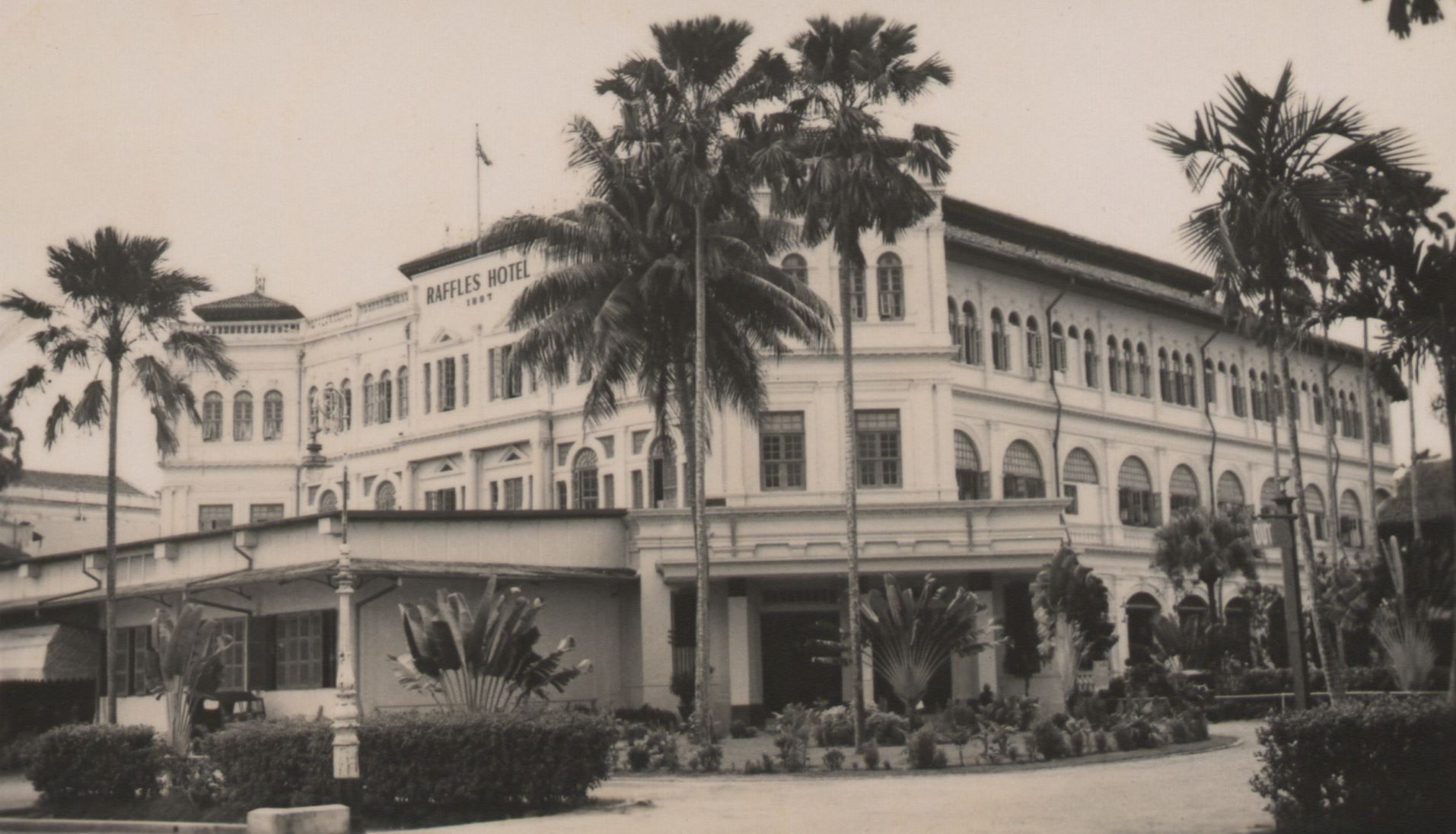 |
| Established by Peranakan bookseller Koh Hoon Teck, Koh & Company was located inside Raffles Hotel (pictured) in 1905. Other than selling postcards and stamps, it also published Baba Malay titles as well as the only philatelic journal at the time – the monthly Postcard Exchange Register. Unfortunately, this unique bookstore ceased operations in the 1920s. (Image Credit: From the Lee Kip Lin Collection. All rights reserved. Lee Kip Lin and National Library Board, Singapore 2009) |
The “Big Three” of Local Chinese Bookstores
Bras Basah also used to house many Chinese bookstores. Among them were three that were considered as the most influential – the Shanghai Book Company, World Book Company and Nanyang Book Company. These bookstores played an important role in shaping Singapore’s book industry.
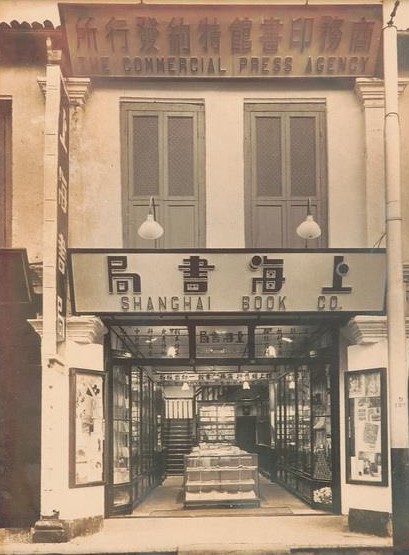 |
| Established in 1925 by Chen Yoh Shoo, the Shanghai Book Company was one of the first local Chinese book companies. Originally located on High Street before moving to North Bridge Road in 1929, it was named after Shanghai not only because most of its books came from there but also because it was the epicentre of China’s New Culture Movement. In its heyday after the Second World War, the company published books in Chinese, English, Malay and Tamil. It ceased operations in December 2008. (Image Credit: Courtesy of the National Museum of Singapore, National Heritage Board) |
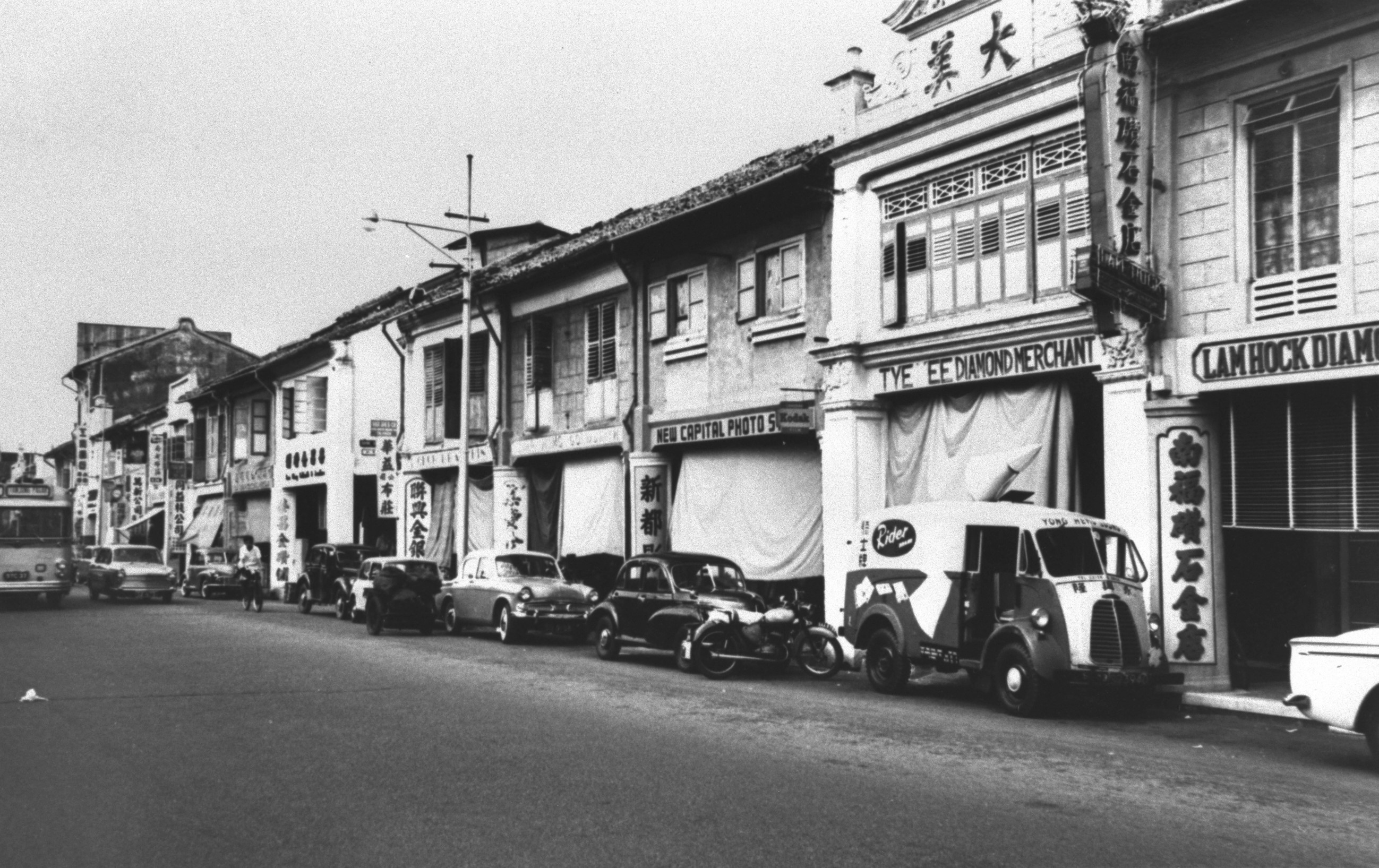 |
| The Nanyang Book Company was founded by Tan Yeok Seong in 1935. Located on North Bridge Road (pictured), it, like many other bookstores of the time, published its own textbooks and periodicals to fulfill the needs of students and to strengthen their sense of identity through the inclusion of content about life in Nanyang. The company expanded its business rapidly and, by 1940, had branches in Penang, Kuala Lumpur and Malacca. In 1963, the book company ceased its operations in Singapore, but its Penang branch is still in operation today. (Image Credit: Courtesy of National Archives of Singapore) |
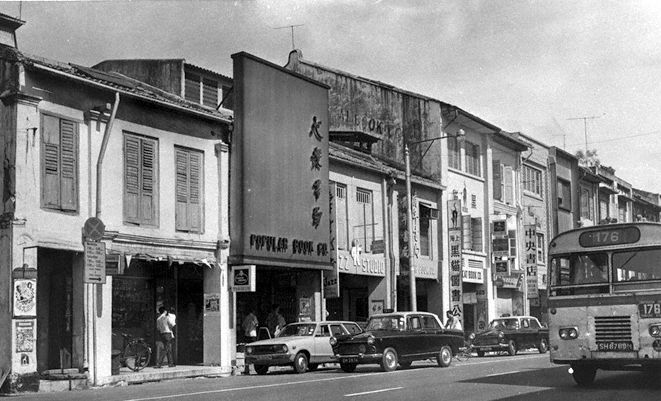 |
| The POPULAR bookstore that we know today was initially called World Book Company. Set up by Chou Sing Chu in 1934, it was located on North Bridge Road, focusing on retailing Chinese books and stationery. In 1936, World Book was renamed Popular Book Company and started expanding its business into the wider region. However, their plans were disrupted by the outbreak of the Second World War. After the war, the bookstore resumed its expansion and quickly become a household name for students and parents in Singapore and the region seeking affordable but quality educational books and stationery. Today, its flagship store is located at Bras Basah Complex. (Image Credit: David Ng Collection, courtesy of National Archives of Singapore) |
In 2016, the Chou Sing Chu Foundation published A Passage of Time to document the history of Singapore's bookstores from 1881 to 2016. The book features veteran local journalist and writer Toh Lam Huat's memories on how these bookstores shaped him. Click or tap HERE to reveal below his account. (Source: Call no.: RSING 070.5095957 CHO )
"In my primary school days, I would go to the World Book Company almost everyday during the school holidays...I would stand and freeload for hours on end, often skipping lunch to do so. My strong interest in literature and science was cultivated from reading the Chinese classics about the legends of the Yang family warriors and the formidable army led by Yue Fei, and many popular science books like Tell Me Why. When I was in secondary school, I frequented many small bookstores on New Bridge Road to buy books. Publications from Hong Kong and Taiwan about history...provided me with the contemporary history knowledge that my textbooks did not [cover]...In my University days, North Bridge Road's Shanghai Book Company and Popular Book Company, and Cashin Street's Student Book Store were among my favourite haunts. However, the two bookstores that I frequented the most then were Union Book Company and South Bridge Road's Cultural Supplies Agency that were selling mainly Taiwanese literary publications."
Bras Basah Complex
Towards the end of the 1970s, many bookstores along Bras Basah and North Bridge roads, including Shanghai Book Company and Popular, were moved to a new building known as Bras Basah Complex.
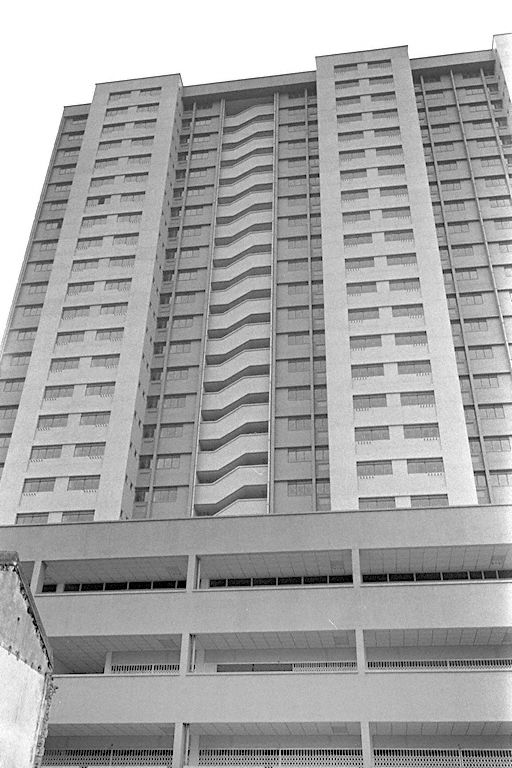 |
| Located along Bain Street, the complex was built by the Housing and Development Board. It was completed in 1979 and comprises two blocks of 21-storey flats above an office-cum-shopping podium. (Image Credit: Ministry of Information and the Arts Collection, courtesy of National Archives of Singapore) |
In his blog, Yeo Hong Eng talks about the POPULAR bookstore in Bras Basah Complex. Click or tap HERE to reveal below what he shared. (Source: Yeo Hong Eng)
"In the 80s and 90s, the whole area of Bras Basah Road, Victoria Street, North Bridge Road underwent a big transformation. The book stores of the areas mentioned either folded up or went over to the Bras Basah Complex. When my sons were of school going age, I brought them over. The Big Book, The World Book, Popular Book Store, Shanghai Book Store, United Publishing House, The Commercial Press, Chung Hwa Book Co, Nanyang Book Company etc were there. These companies were not strangers to me. As I was the Head of English Department in Gongshang Primary School then, every year I received numerous review copies of children’s books, assessment books, model compositions, etc from these various publishers and book companies. The most popular was the Popular Book Store as it was the biggest bilingual and most attractive store there. Many of my sons’ reference and story books were from there. One of the best buys was a set of Children’s Encyclopaedia which I still have today...Today the Popular Book Store not only sell Chinese and English books, school text and assessment books, stationery etc, it also sells music CDs, DVDs, computer printers, games, and other software."
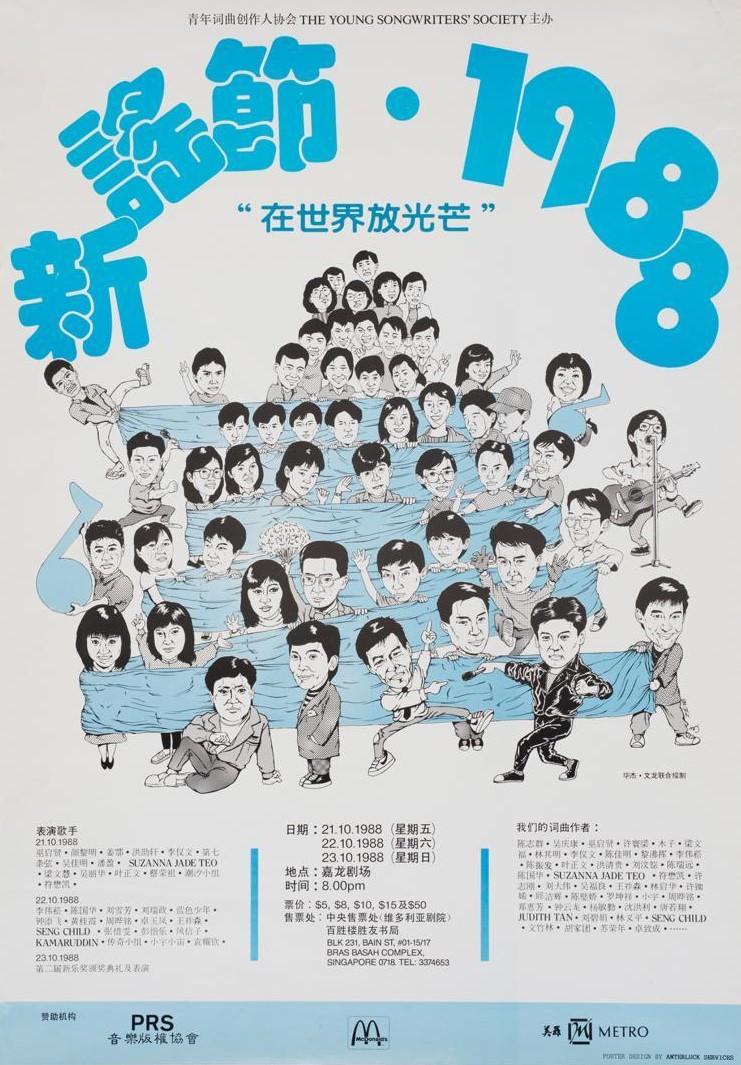 |
| During the 1980s, this place was also a popular venue for Singapore “xinyao” singers to launch and promote their songs. To further help these amateur singers, the Young Songwriters’ Society (YSS) (above) started the annual Xinyao Festival in 1986 as a platform for them to perform. If you are not sure what xinyao is, click or tap on the question below to find out. You can also visit MusicSG to listen some of the xinyao songs. (Image Credit: Courtesy of the National Museum of Singapore, National Heritage Board) |
What is "Xinyao"? Click or tap HERE to reveal the answer below.
Xinyao is an abbreviated form of 新加坡歌谣 (“Singapore songs” in Mandarin). It is a genre of music that refers to Mandarin ballads composed, written and performed by youths in Singapore. Started in the early 1980s in local schools and college campuses, the Xinyao movement propelled many local singers and singer-songwriters to stardom. Big names often associated with the xinyao movement include Eric Moo (巫启贤), Billy Koh (许环良), Liang Wern Fook (梁文福) and Roy Loi (黎沸挥).
 |
| Although the Xinyao movement has faded into yet another page of our history, Bras Basah complex is still standing along Bras Basah Road, serving as a one-stop centre for educational books and art materials. (Image Credit: Photo by Sengkang via Wikicommons) |
Watch this short video by students from the Nanyang Academy of Fine Arts and National Museum of Singapore on the significance of Bras Bash Complex.
The National Museum and National Library
Between schools and bookstores, the Bras Basah area continues to be a place for knowledge today. This is largely due to the presence of both the National Library and National Museum in the district since the mid-1800s.
The National Museum
With its iconic dome, the National Museum of Singapore has been a prominent landmark on Stamford Road for over a century. Gazetted as a national monument on 14 February 1992, it is Singapore’s oldest existing museum, currently devoted to the general history of Singapore.
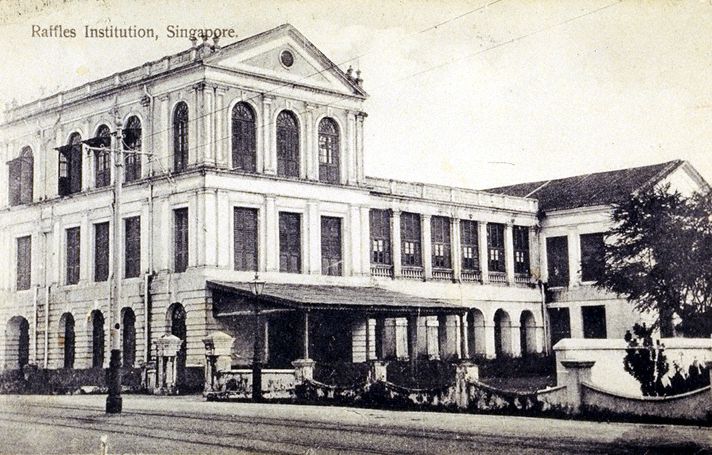 |
| The establishment of a museum was first mooted in 1823, when Sir Stamford Raffles proposed founding a college in Singapore. However, this was not realised until 1849. Set up within the Singapore Library, the museum was located together with the library in the premises of Singapore Institution (today’s Raffles Institution, shown above) before moving to the Town Hall (present-day Victoria Theatre) in 1862. (Image Credit: Courtesy of National Archives of Singapore) |
 |
| In 1874, the museum and the Singapore Library were combined to form the Raffles Library and Museum. However, it would take more than a decade before the new institution moved to the museum’s present building in 1887. Designed by Colonial Engineer Henry E. McCallum, it was built in a neo-Palladian style, characterised by a highly symmetrical facade, as well as the use of pediments above the windows, Doric columns and pilasters on the ground level and Ionic pilasters on the second level. (Image Credit: Courtesy of the National Museum of Singapore, National Heritage Board) |
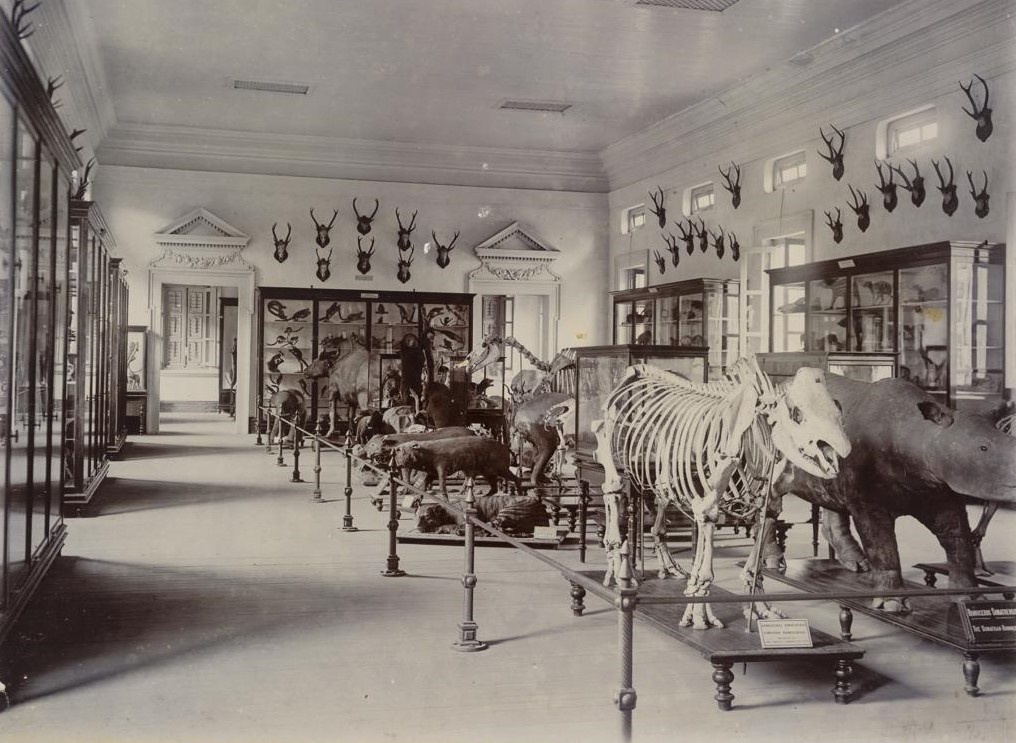 |
| Initially, the museum was positioned as repository of zoological specimens, documenting the natural history of Singapore and the region. Towards the end of the 1800s, it expanded its collection to include portraits, plans and photographs of old Singapore. After the museum was separated from the library and following Singapore’s independence, it shifted its focus to reflect the nation’s culture and history. (Image Credit: Courtesy of the National Museum of Singapore, National Heritage Board) |
Christopher Hooi was the Director of the National Museum from 1979 to 1982. Click or tap HERE to reveal below his explanation why there was a shift in the museum’s focus. (Source: National Archives of Singapore )
"[T]raditionally, the museum should be a repository of the nation’s heritage. That is understood because without a museum then what is important to a national will be lost….[But] it should be not [just] a repository [but also] a fine centre of display…It should be a place of education. To teach people things; to entertain them; to educate them…it should draw them to come to the museum so that there is a meaning a reason to come to the museum."
The National Library
The former National Library Building was located at 91 Stamford Road. It officially opened on 12 November 1960. Between 1887 and 1960, the National Library occupied the western wing of the Raffles Museum (now National Museum of Singapore) at Stamford Road.
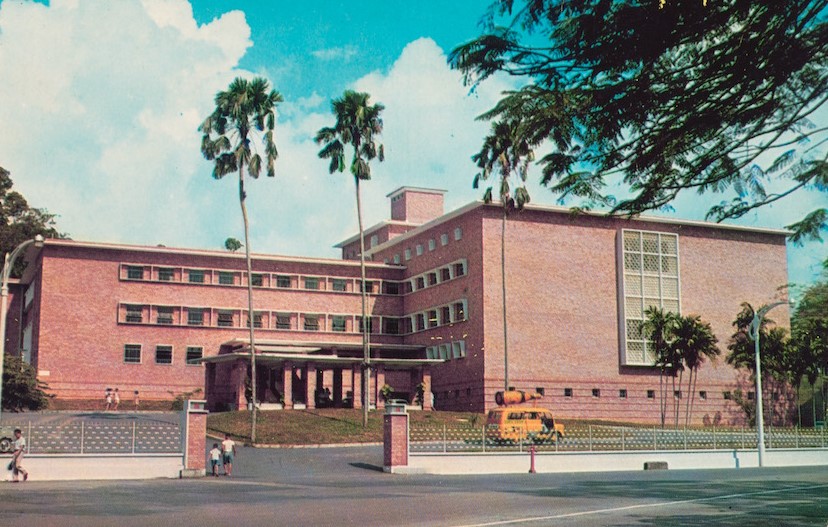 |
| The National Library on Stamford Road was designed by Public Works Department architect Lionel Bintley, while the project architect was Tio Seng Chin. The completed library had a reinforced concrete framed structure and was easily recognised by its iconic red brick walls, which reflected the epoch of British architecture in the 1950s. (Image Credit: Courtesy of the National Museum of Singapore, National Heritage Board) |
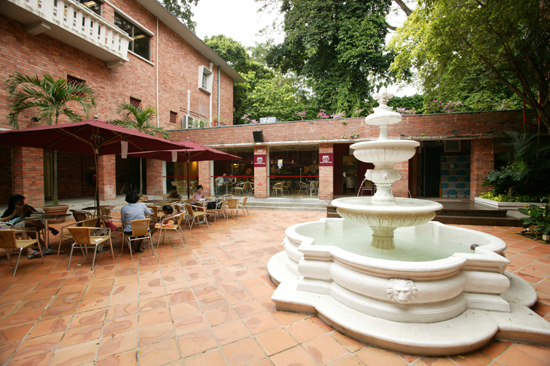 |
| The total floor area of the new building was 101,500 sq ft. The ground floor comprised the exhibition hall, adult lending library, children’s library, children’s activities room and lecture hall. The mezzanine floor housed administrative offices and a stack area, while the reference library, microfilm reading room and a conference room were located on the first floor. (Image Credit: All Rights Reserved. National Library Board Singapore 2004) |
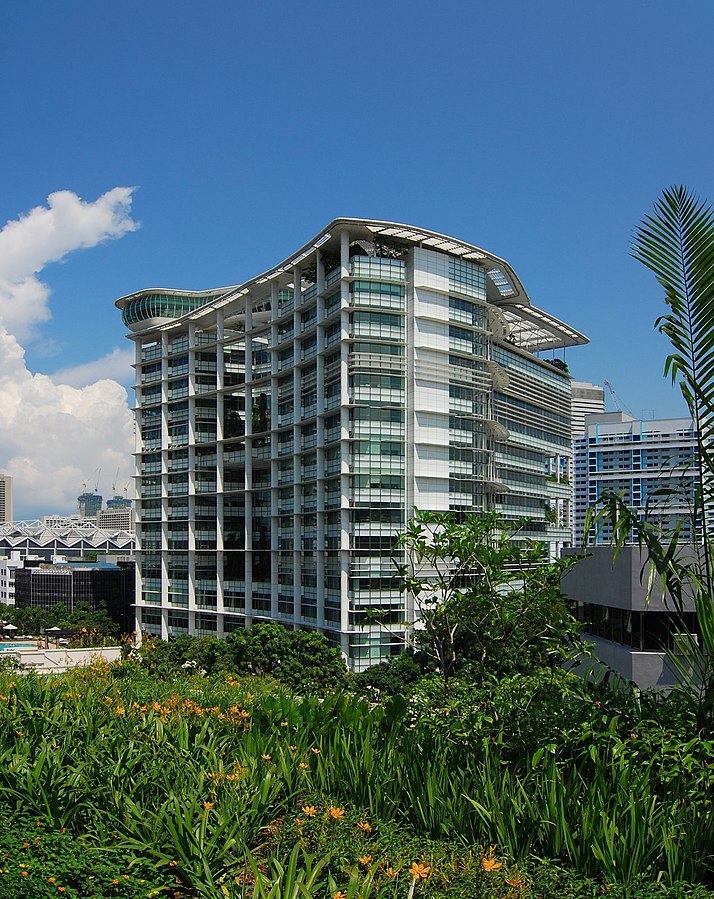 |
| In 1998, it was announced that the National Library on Stamford Road would be demolished to make way for the Singapore Management University (SMU) and construction of Fort Canning tunnel, prompting calls to preserve the building. The red-bricked library was eventually demolished in 2004. Today, the National Library in located in an ultra-modern building located on Victoria Street. However, the gates of the old library can still be found within the premises of SMU. (Image Credit: Photo by William Cho via wikicommons) |
When the National Library on Stamford Road closed its doors on 1 April 2004 (to relocate to its present site at Victoria Street), it concluded a chapter of its rich history of serving the people for 44 years. To preserve the memories of the beloved library, the National Library Board published Moments In Time (2004), which captured the stories of its patrons. Click or tap HERE to reveal below an entry by Gary Lim. (Source: Call no.: RSING 070.5095957 CHO )
"My memories of the National Library centre around the varied encounters and experiences that were inevitably the product of looking for information and books, while growing up in the 1980s and 1990s. I remember when I was in Secondary Two and had to do a project on science in sport - how there was only a single book in the library system which was located in the national reference library...I remember that it was there that I learned how to operate the microfiche machines, in search for newspaper reports on the Hock Lee Bus strikes; that when in Secondary Four, how my classmates and I did a project on creation and evolution and ended up chatting with girls from an assortment of schools while waiting in the photocopy queues. I remember how as a 17-year-old I discovered Jack Keroauc and Ken Kesey and an assortment of poets and writes on lonely Sunday afternoons - books that had lain unborrowed for years, on the shelves of the library and greedily calculated how many I could check out. These were the days before the Internet, before Borders or Kinokuniya and the National Library certainly expanded my horizons."
Little Red Bricks
Though the old National Library was demolished in 2004, it will live on forever in the memories of countless Singaporeans who frequented it over the decades. Local animation studio Robot Playground immortalised the National Library on Stamford Road in a 15-minute animated short titled Little Red Bricks. It pays tribute not only to the building but also the people through the life and times of a boy and a girl. Watch the breath-taking video below.
Truly, A Place For Books and Knowledge
While the photos and memories above might provide insight into how Bras Basah thrived as a place for books and knowledge, this becomes even clearer when we plot some of these places on a map. See the story map below to see what we mean.


